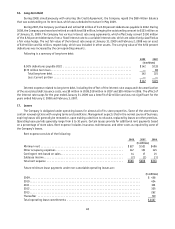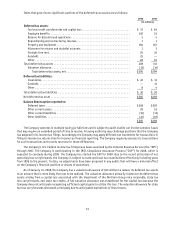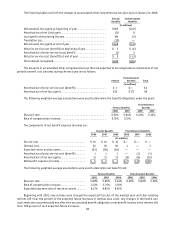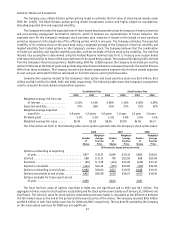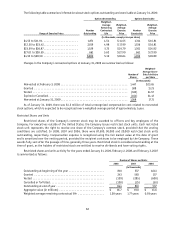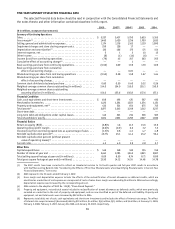Foot Locker 2008 Annual Report Download - page 71
Download and view the complete annual report
Please find page 71 of the 2008 Foot Locker annual report below. You can navigate through the pages in the report by either clicking on the pages listed below, or by using the keyword search tool below to find specific information within the annual report.55
Business Risk
The retailing business is highly competitive. Price, quality, selection of merchandise, reputation, store location,
advertising and customer service are important competitive factors in the Company’s business. The Company operates
in 21 countries and purchased approximately 80 percent of its merchandise in 2008 from its top 5 vendors. In 2008,
the Company purchased approximately 64 percent of its athletic merchandise from one major vendor and approximately
9 percent from another major vendor. Each of our operating divisions is highly dependent on Nike; they individually
purchase 44 to 78 percent of their merchandise from Nike. The Company generally considers all vendor relations to be
satisfactory.
Included in the Company’s Consolidated Balance Sheet as of January 31, 2009, are the net assets of the Company’s
European operations, which total $545 million and which are located in 17 countries, 11 of which have adopted the euro
as their functional currency.
23. Fair Value Measurements
On February 3, 2008, the Company adopted SFAS No. 157, “Fair Value Measurements” (“SFAS No.157”). SFAS No. 157
provides a single definition of fair value and a common framework for measuring fair value as well as new disclosure
requirements for fair value measurements used in financial statements. Under SFAS No. 157, fair value is determined
based upon the exit price that would be received to sell an asset or paid to transfer a liability in an orderly transaction
between market participants exclusive of any transaction costs. SFAS No. 157 also specifies a fair value hierarchy
based upon the observability of inputs used in valuation techniques. Observable inputs (highest level) reflect market
data obtained from independent sources, while unobservable inputs (lowest level) reflect internally developed market
assumptions.
In February 2008, the FASB issued FSP FAS 157-1, “Application of FASB Statement No. 157 to FASB Statement No.
13 and Other Accounting Pronouncements That Address Fair Value Measurements for Purposes of Lease Classification
or Measurement under Statement 13” (“FSP FAS 157-1”). FSP FAS 157-1 amended SFAS No. 157 to exclude from its scope
SFAS No. 13, “Accounting for Leases,” and its related interpretive accounting pronouncements that address leasing
transactions. Also in February 2008, the FASB issued FSP FAS 157-2, “Effective Date of FASB Statement No. 157” (“FSP
FAS 157-2”). FSP FAS 157-2 amended SFAS No. 157 to defer the effective date of SFAS No. 157 for non-financial assets
and non-financial liabilities, except for items that are recognized or disclosed at fair value in the financial statements
on a recurring basis, at least annually until fiscal years beginning after November 15, 2008. The Company is currently
assessing the impact of SFAS No. 157 on its non-financial assets and non-financial liabilities measured at fair value on
a nonrecurring basis.
In accordance with SFAS No. 157, fair value measurements are classified under the following hierarchy:
Level 1 – Quoted prices for identical instruments in active markets.
Level 2 – Quoted prices for similar instruments in active markets; quoted prices for identical or similar instruments
in markets that are not active; and model-derived valuations in which all significant inputs or significant value-
drivers are observable in active markets.
Level 3 – Model-derived valuations in which one or more significant inputs or significant value-drivers are
unobservable.





